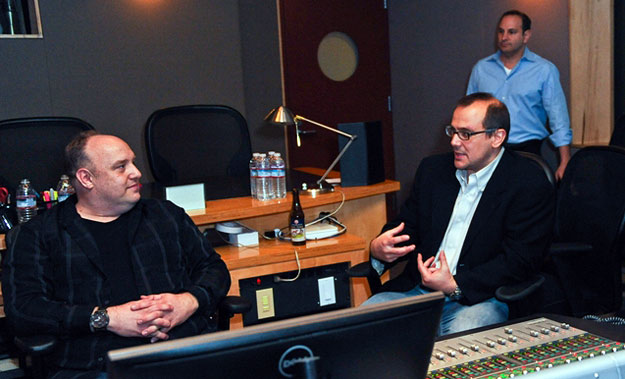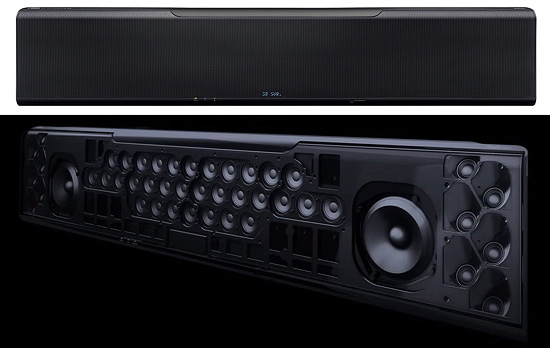 [... back to Page 1] Still with us? Good!
[... back to Page 1] Still with us? Good!
Now then… last Thursday afternoon, I had the good fortune to visit Formosa Group’s mixing facility in Santa Monica, to take in a demonstration of Dolby Atmos. As you can imagine, with so much attention being paid to 4K Ultra HD Blu-ray of late, it’s only natural that a lot of Bits readers are asking us questions about the format’s new object-based audio formats. So I was pleased to have the chance to experience an Atmos home demonstration first-hand and to get a look at how Atmos mixes are created. Some of you may already have experienced Dolby Atmos in your local cineplex, but you’re likely wondering, how does that experience translate to the home? How does Atmos sound in a home theater or even a living room? Does it really make a difference? Is it noticeably better or different that the core Dolby TrueHD 7.1 mixes already common to regular Blu-ray releases? Read on...
Formosa Group’s Santa Monica office is one of several facilities the company operates in Hollywood and elsewhere. The building was once POP Sound, so I’d been there several times before to watch DVD and Blu-ray audio commentaries being recorded. Formosa does lots of theatrical sound work, including the Sound Supervision for recent Atmos mixes of such films as Star Trek Beyond, The Revenant, and Mad Max: Fury Road. For this event, Dolby and Formosa Group had set-up two Atmos experiences focused on home theater. The first was a demonstration of Yamaha’s new YSP-5600 sound bar, which is designed specifically for use with Dolby Atmos and DTS:X.
One of the first things people wonder about Atmos is: Is it really worth buying the extra speakers to take advantage of the format’s height channels? But here’s the thing – with the YSP-5600, you don’t have to. The sound bar is designed for small and medium-sized home theater installations. It’s literally all you need: It delivers 7.1.2 channels using a remarkable 44 speaker drivers, each pointed at different angles around the room within the sound bar.
As the demonstration began, which included a sequence from a Game of Thrones episode in Atmos and also a recent Eric Clapton: Crossroads concert, I was duly impressed by the quality of the surround sound the 5600 delivered. Naturally, Atmos is lossless like the core TrueHD mix it’s based on, but the height channels really do help to create a smoother and bigger front soundstage. What shocked me, however, was when I turned my head to see where all the various height, surround, and surround back speakers were positioned… only to discover that there weren’t any. The entire and fully immersive 7.1.2 experience was coming from the sound bar alone. No kidding. Now, the Yamaha YSP-5600 will set you back around $1600, but it is quite literally surround sound in a box. It’s one of the most extraordinary audio products I’ve seen in the 19 years I’ve been running The Bits.
Here’s some details from Yamaha’s own product page on the unit: “Beautifully designed with 44 precisely calculated and positioned beam drivers and two woofers, the YSP-5600 effectively creates 7-channel sound beams (front left/right, center, surround left/right, height left/right). Using Yamaha Digital Sound Projector technology, each speaker is controlled by individual delay times and is driven with its own independent amplifier circuit. These beams are projected onto the walls and ceiling, and reflected to the listening position.” I’m here to tell you, it works. I was blown away. If you’re a casual home theater enthusiast, or a budget-minded movie buff, and especially if you have a small to medium-sized home theater space, the YSP-5600 is perfect for you.
After this demonstration, we moved into one of Formosa’s large mixing stages, where veteran feature film re-recording mixer and sound editor Tim Hoogenakker demonstrated the process of creating a good Atmos mix for the home, using those same clips and a few others that he’d specifically mixed in Atmos just for this demonstration. It’s worth noting that Formosa has mixed about a third of all the Atmos BD and 4K titles currently available or announced, and Tim personally has done many of the forthcoming Sony 4K Ultra HD Blu-ray Atmos mixes (including both Ghostbusters films and Labyrinth).

Walking us through each demo, Tim explained the benefits of Atmos, which essentially allows him to position sounds three-dimensionally around the home theater listening space and them move them around the room to simulate the way real-world objects move around you in reality. This effect, combined with the height channels, creates a much more natural and immersive soundscape for the listener. No longer are you simply listening to the usual 5.1 channels – you’re surrounded by a virtual 3D audio environment that pans and fills sound cues from speaker to speaker around you much more naturally. And again, the front part of the soundstage is bigger and smoother too. So the answer to the question “Does Atmos really make a difference?” is certainly yes, and in fact much more of a difference than you might anticipate.
Now, if you already have a good 5.1 or 7.1 speaker system, the cost of adding two more speakers (to take advantage of the height channels), and possibly upgrading your A/V receiver to be compatible with Atmos and DTS:X too, might be restrictive. Some of you may not have the ability to mount additional speakers higher on your front wall or on the ceiling. And some of you may have angled ceilings, which would make reflective speaker options ineffective. The good news is that there are options for you no matter what your situation. Indeed, if you can add additional speakers, so much the better. If you don’t already have surround sound at all, the all-in-one sound bar (like the YSP-5600) is a great option. And if you don’t have the room to mount additional speakers but still have 5.1 or 7.1, there are new front left and right tower speakers that have top-firing drivers to give you the height channels you need. In any case, if you’re a serious home theater enthusiast – serious enough to upgrade to a 4K display or projector and Ultra HD for its improved video – then you really do owe it to yourself to add next-generation sound capability to the experience as well at some point. It’s certainly not going to diminish your movie viewing experience in any way if you don’t, but it will definitely enhance that experience if you do.
I’d like to take a quick moment to thank Tim Hoogenakker and everyone at Formosa Group for their hospitality, as well as the folks from Dolby, and also our old friends Sue Procko and Ed Peters (of Sue Procko PR) for their time and efforts in arranging this demonstration. Rest assured, I’ll have more to say about Atmos in the weeks and months ahead.

All right, that’s all for today. Be sure to check back with us tomorrow here at The Bits, because we’ll have more release news and disc reviews for you, including my thoughts on Warner’s recently-announced Creed in 4K Ultra HD!
Stay tuned...
- Bill Hunt (@BillHuntBits)





